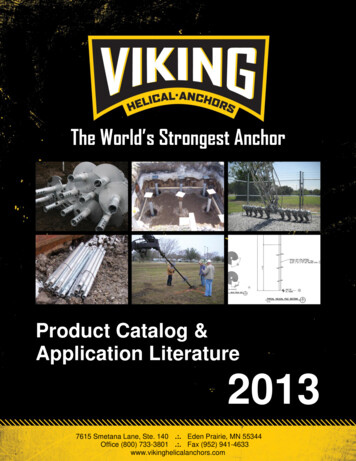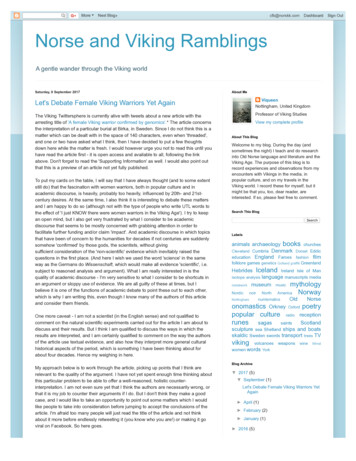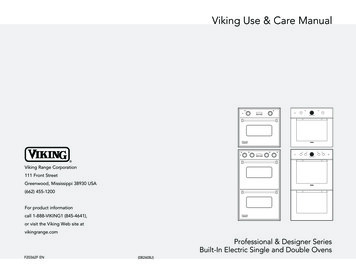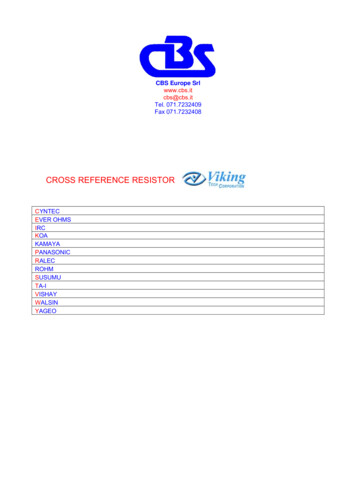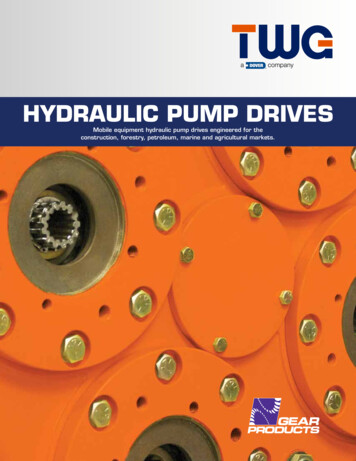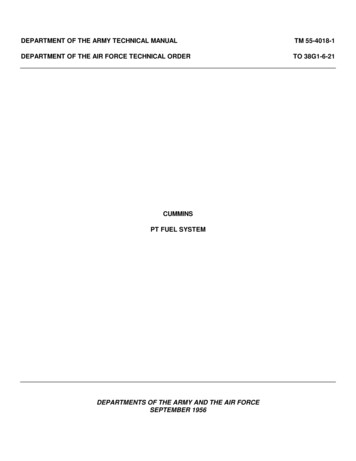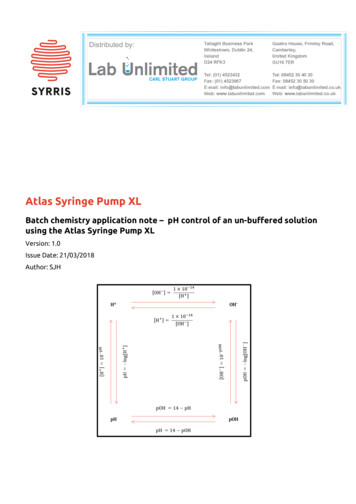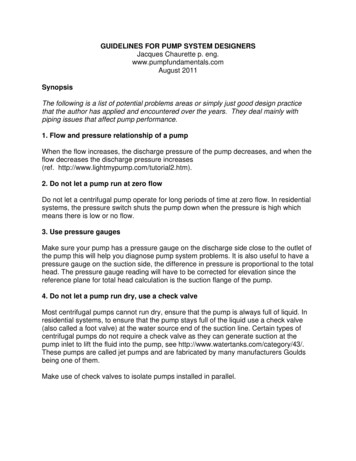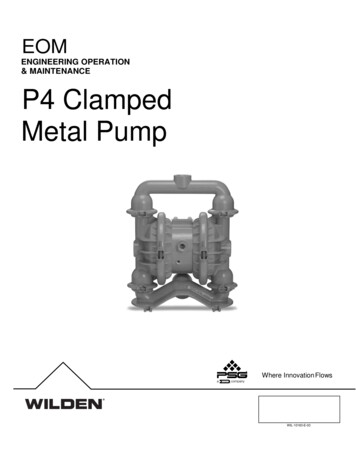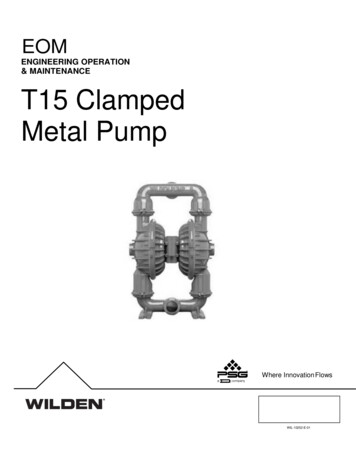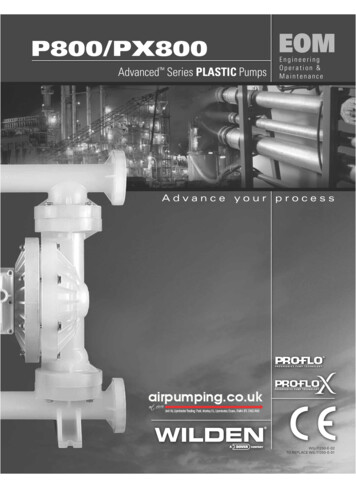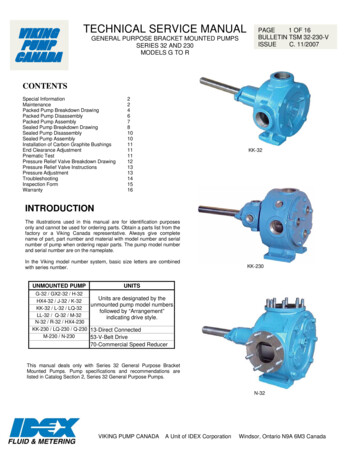
Transcription
TECHNICAL SERVICE MANUALGENERAL PURPOSE BRACKET MOUNTED PUMPSSERIES 32 AND 230MODELS G TO RPAGE1 OF 16BULLETIN TSM 32-230-VISSUEC. 11/2007CONTENTSSpecial InformationMaintenancePacked Pump Breakdown DrawingPacked Pump DisassemblyPacked Pump AssemblySealed Pump Breakdown DrawingSealed Pump DisassemblySealed Pump AssemblyInstallation of Carbon Graphite BushingsEnd Clearance AdjustmentPnematic TestPressure Relief Valve Breakdown DrawingPressure Relief Valve InstructionsPressure AdjustmentTroubleshootingInspection DUCTIONThe illustrations used in this manual are for identification purposesonly and cannot be used for ordering parts. Obtain a parts list from thefactory or a Viking Canada representative. Always give completename of part, part number and material with model number and serialnumber of pump when ordering repair parts. The pump model numberand serial number are on the nameplate.In the Viking model number system, basic size letters are combinedwith series number.UNMOUNTED PUMPKK-230UNITSG-32 / GX2-32 / H-32Units are designated by theHX4-32 / J-32 / K-32unmounted pump model numbersKK-32 / L-32 / LQ-32followed by “Arrangement”LL-32 / Q-32 / M-32indicating drive style.N-32 / R-32 / HX4-230KK-230 / LQ-230 / Q-230 13-Direct ConnectedM-230 / N-23053-V-Belt Drive70-Commercial Speed ReducerThis manual deals only with Series 32 General Purpose BracketMounted Pumps. Pump specifications and recommendations arelisted in Catalog Section 2, Series 32 General Purpose Pumps.N-32VIKING PUMP CANADAA Unit of IDEX CorporationWindsor, Ontario N9A 6M3 Canada
DANGERBEFORE OPENING ANY PUMP LIQUID CHAMBER (PUMPING CHAMBER, RESERVOIR, RELIEF VALVE ADJUSTINGCAP FITTING ETC.) BE SURE:1.THAT ANY PRESSURE IN CHAMBER HAS BEEN COMPLETELY VENTED THROUGH SUCTION OR DISCHARGELINES OR OTHER APPROPRIATE OPENINGS OR CONNECTIONS.2.THAT THE DRIVING MEANS (MOTOR, TURBINE, ENGINE, ETC.) HAS BEEN “LOCKED OUT” OR MADE NONOPERATIONAL SO THAT IT CANNOT BE STARTED WHILE WORK IS BEING DONE ON PUMP.3.THAT YOU KNOW WHAT LIQUID THE PUMP HAS BEEN HANDLING AND THE PRECAUTIONS NECESSARY TOSAFELY HANDLE THE LIQUID. OBTAIN A MATERIAL SAFETY DATA SHEET (MSDS) FOR THE LIQUID TO BESURE THESE PRECAUTIONS ARE UNDERSTOOD.FAILURE TO FOLLOW ABOVE LISTED PRECAUTIONARY MEASURES MAY RESULT IN SERIOUS INJURY OR DEATH.ROTATION: Rotary gear pumps operate equally well in a clockwise orcounterclockwise rotation. The shaft rotation determines which port is suction andwhich is discharge. Port in area where pumping elements (gear teeth) come out ofmesh is suction port.PRESSURE RELIEF VALVES:1. Rotary gear pumps are positive displacement pumps and must be provided withsome sort of pressure protection. This may be a relief valve mounted directly on thepump, an inline pressure relief valve, a torque limiting device or a rupture disk.2. There are relief valve options available on those pump models designed to accept arelief valve. Options may include a return to tank relief valve and a jacketed reliefvalve. Pumps equipped with a jacketed head are not available with a relief valve.Figure 1, Head orientation3. If pump rotation is reversed during operation, pressure protection must be providedon both sides of pump.4. Relief valve bonnet must always point towards suction side of pump. If pumprotation is reversed, remove pressure relief valve and turn end for end. Figures 2and 3 show the 2 possible configurations, Figure 2 has side suction and topdischarge. Figure 3 has top suction and side discharge. The shaft turns in theopposite direction on the second pump.5. Pressure relief valves cannot be used to control pump flow or regulate dischargepressure.SPECIAL INFORMATIONSPECIAL MECHANICAL SEALS can be installed either next to rotor hub or behind thebracket bushing.Figure 2Extra care must be taken in repair of pumps with mechanical seals. Read and follow allspecial information supplied with pump.MAINTENANCESeries 32 pumps are designed for long, trouble-free service life under a wide variety ofapplication conditions with a minimum of maintenance. The points listed below will helpprovide long service life.LUBRICATION: External lubrication must be applied slowly with a handgun to alllubrication fittings every 500 hours of operation with multi-purpose grease. Do not overgrease. Applications involving very high or low temperatures will require other types oflubrication. Consult factory with specific lubrication questions.PACKING ADJUSTMENT: New packed pumps require initial packing adjustment tocontrol leakage as packing “runs in”. The adjustment should be made while the pump isoperating with normal operating pressure on the discharge of the pump. Make2Figure 3
adjustments carefully and do not over-tighten packing gland. Evenly tighten the glandfasteners until the leak is reduced to a very slow drip. If over tightened the packingwill over heat, score the shaft and reduce life. After initial adjustment, inspectperiodically for increased leakage and re-adjust. Once the gland has been tightenedto the stuffing box, loosen the packing gland and add one ring to the stuffing box, thenadjust again. Refer to instructions under Disassembly, page 6, and Assembly, page 7,regarding repacking pump.CLEANING PUMP: Keep pump as clean as possible. This will facilitate inspection,adjustment and repair work and help prevent overlooking a dirt covered grease fitting.STORAGE: If pump is to be stored, or not used for six months or more, pump mustbe drained and a light coat of lubricant and rust preventative suitable to theapplication must be applied to all internal pump parts. Lubricate fittings and applygrease to pump shaft extension. Viking suggests rotating pump shaft by hand, onecomplete revolution every 30 days to circulate the oil.SUGGESTED REPAIR TOOLS: The following tools must be available to properlyrepair Series 32 pumps. These tools are in addition to standard mechanics’ tools suchas open-end wrenches, pliers, screwdrivers, etc. Most of the items can be obtainedfrom an industrial supply house.Figure 4, Idler bushing press fit1. Soft Headed hammer2. Allen wrenches (some mechanical seals and set collars)3. Packing hooks, flexible (packed pumps)Small for 1/4 inch and 3/8 inch cross section packingLarge for 3/8 inch and larger cross section packing4. Arbor pressStrainers: Use a strainer on the suction side of the pump to prevent foreign materialfrom entering the pump causing damage to the gears, and casing or lock-up thepump. Keep the strainer on the suction side of the pump clean and free of debris. Ablocked strainer will not allow sufficient liquid to reach the pump. The lack of liquidreaching the pump will create cavitation. Cavitation is when the liquid vaporizes on itsway to the pump, then returns to a liquid form on the surfaces of the pump. This isvery noisy, damaging to a pump, and seriously affects the output.Figure 5, Pressing the idler pinFigure 6, Casing bushingorientationFigure 7, Casing, rotor & shaftass’y3
PACKED PUMPSExploded View for Packed Models: G-32, GX2-32, H-32,HX4-32, J-32, K-32, KK-32 and L-32Exploded View for Packed Models: LQ-32 and LL-32ITEM123456NAME OF PARTPacking gland fastenersPacking glandPacking ringsGrease fittingCasing bushingCasingITEM789101112NAME OF PARTCasing & bushing ass’yPipe plugRotor & shaft ass’yIdlerIdler bushingIdler & bushing ass’y4ITEM1314151617NAME OF PARTHead gasketIdler pinHeadHead & pin ass’yHead bolts
PACKED PUMPS21Exploded View for Packed Models: LQ-230, Q-32, Q-230,M-32, M-230, N-32, N-230 and R-32ITEM1234567NAME OF PARTPacking gland fastenersPacking GlandPacking ringsRBS bushingRotor bearing sleeve (RBS)RBS and bushing ass’yRBS fastenersPacked Cross SectionPacking GlandITEM891011121314NAME OF PARTGrease fittingRBS GasketCasingRotor and shaft ass’yIdlerIdler bushingIdler and bushing ass’yITEM15161718192021NAME OF PARTHead gasketIdler pinHeadIdler pin boltHead and idler pin ass’yHead fastenersPipe plugCasingPacking Rings5Casing Bushing
DISASSEMBLY OF PACKED PUMPSNote: For large pump models the use of a lifting device is advised.1.Remove the packing gland fastener, and pull the gland out of the stuffing box, and off of theshaft.2.Mark head and casing before disassembly to insure proper re-assembly. The idler pin, which isoffset in pump head, must be positioned toward and centered between the port connections toallow for proper flow of liquid through pump. Figure 1, page 2.Remove head from pump. Do not allow idler to fall from idler pin. Tilt top of head back and downwhen removing to prevent this. The idler and bushing should stay on the idler pin. If pump isfurnished with pressure relief valve, it need not be removed from head or disassembled at thispoint. Refer to Pressure Relief Valve Instructions, page 12.The gaskets must be totally removed. Use new gasket when assembling pump.3.Remove idler and bushing assembly from the idler pin.4.Tap the shaft forward with a softheaded hammer, and pull it out of the casing and bushingassembly. Large assemblies can be supported with a hoist and rope or strap around a rotortooth.5.The packing may be removed with a packing puller. In some cases two pullers will be required,or pushed out with a chisel and a hammer from the bushing side (be careful not to damage thebushing). If removal, still cannot be done with the pullers, or chisel, stand the casing on the faceof the stuffing box and press the bushing out through the packing area. This will remove all ofthe packing with the bushing.6.Clean all parts thoroughly and examine for wear and damage. Check all parts for nicks, burrs,excessive wear and replace if necessary.7.Check the bearings for roughness. Roughness can be determined by turning the inner and outerrace in opposite directions by hand. Note if the motion is smooth and free or rough and stiff.Smooth and free is desired.8.The casing bushing can also be inspected while still in the casing. If replacement is necessary,and not already removed in step 5, stand the unit on the head-mounting surface and push thebushing out with a round bar through the packing end of the casing.Note: For models Q, M, N and R the rotor bearing sleeve can be removed from the casing to makeremoval of the bushing easier.9.Figure 8, Mounting headFigure 9, Alternate the packingcutsIf the idler pin is worn, remove the grease fitting, and support the casing on the crescent side asclose as possible to the idler pin. Press the pin out.10. If the idler bushing is worn it can be pressed out of the idler. However the idler will likely be wornas mush as the bushing, therefore it is recommended that the complete assembly be replaced.Figure 10, Pushing in the packingrings6
ASSEMBLY OF PACKED PUMPSRotary gear pumps are supplied with a wide variety of bushing materials. These materials should notall be treated the same. See “Bushing Material” page 11.1. Press the idler bushing into the idler gear. Figure 4, page 3. Refer to Installation of CarbonGraphite Bushing see page 11.Note: Some bushings have a small step in the diameter on one end to assist in the alignment andstarting.2. Coat the idler pin with non-detergent SAE 30 weight oil and using the idler bushing as a guide,press the idler pin into the head with the tapped hole in and the groove pointing toward the centerof the crescent. Figure 5, page 3Figure 11, Gland & fastenersinstalled3. Install the casing bushing. If the bushing has a lubrication groove, install bushing with thelubrication hole aligned with the grease-fitting hole on the casing. Figure 6, page 3. If carbongraphite, refer to Installation of Carbon Graphite Bushings, page 11.Note: Q, M,N and R pumps have RBS bushings installed in the rotor bearing sleeve which is mountedon the back side of the casing. Figure 12 & 134. Coat the shaft of the rotor and shaft assembly with non-detergent SAE 30 weight oil. Start the endof shaft in the casing bushing and slowly push the shaft through bushing. Continue until the rotorand shaft assembly cannot move any further. Figure 7, page 3.5. Perform all step in “END CLEARANCE ADJUSTMENT” page 11,6. Use only new packing suitable for the liquid being pumped. Install the packing, staggering the jointsfrom one side of shaft to other, Figure 9, page 6. If needed, lubricate packing rings with oil, greaseor graphite to aid assembly. Use the packing gland or a length of pipe to seat each packing ring,Figure 10, page 6.7. Install packing gland, capscrews and nuts. Make sure the gland is installed square and nuts areonly finger tight. Figure 11. Refer to “Packing Adjustment” page 2 after the pump is assembled andinstalled.Figure 12, RBS bushinginstallation8. Replace the grease fittings and pipe plugs.9. Lubricate all grease fittings with multi-purpose grease.Figure 13, Installing the Seal7
MECHANICAL SEAL PUMPSExploded View for Mechanical Seal Models: G-32, GX2-32, H-32,HX4-32, HX4-230, J-32, K-32, KK-32, KK-230 and L-32Exploded View for Mechanical Seal Models: LQ-32 and LL-32ITEM1234567NAME OF PARTSeal seat retainer fastenersSeal seat retainerRetainer o-ringMechanical seal assemblyDriving ringSet screwGrease fittingITEM891011121314NAME OF PARTCasing bushingCasingCasing and bushing assemblyPipe plugRotor and shaft assemblyIdlerIdler bushing8ITEM151617181920NAME OF PARTIdler and bushing assemblyHead gasketIdler pinHeadHead & pin ass’yHead bolts
MECHANICAL SEAL PUMPS24Exploded View for Mechanical Seal Models: LQ-230, Q-32, Q-230,M-32, M-230, N-32, N-230 and R-32ITEM123456789101112NAME OF PARTSeal seat retainer fastenersSeal seat retainerRetainer o-ringMechanical seal assemblyDriving RingDriving Ring SetscrewsRBS BushingRotor Bearing Sleeve (RBS)RBS & Bushing Assy.RBS FastenersGrease FittingRBS GasketITEM131415161718192021222324NAME OF PARTCasingRotor & Shaft Assy.IdlerIdler BushingIdler & Bushing Assy.Head GasketIdler PinHeadIdler Pin NutHead & pin Assy.Head FastenersPipe PlugMechanical Seal Cross SectionSeal Seat RetainerStationary SeatCasingSpringPipe PlugDriving RingRotating Seat9
DISSASSEMBLY OF SEALED PUMPS1. Remove the fasteners from the seal seat retainer and pull it away from the seal chamber.Remove the rotating seat and the spring from the shaft.2. Remove the pipe plug from the casing in the side of the seal chamber and loosen the 2 setscrewson the driving ring through the tapped hole in the side of the seal chamber. Figure 163. Remove the driving ring from the shaft.Figure 14, Install stationary seat4. Do steps 2 through 4 under “DISASSEMBLY OF PACKED PUMPS”.5. Do steps 6, through 10 under “DISASSEMBLY OF PACKED PUMPS”ASSEMBLY OF SEALED PUMPSThe seal used in this pump is simple to install and good performance will result if care is taken duringinstallation.The principle of the mechanical seal is that contact between the rotary and stationary members.These parts are lapped to a high finish and their sealing effectiveness depends on complete contact.A number of pumps are supplied with special mechanical seals. These special seals are notdiscussed in TSM 32. Information is available by contacting the factory. When requesting specialseal information, be sure to give pump model number and serial number.Figure 15, Setting the driving ringThere is a wide variety of bushing materials available, these materials should not all be treated thesame. See “Bushing Material” page 11.1. Repeat steps 1 through 5 of Packed Pump Assembly.2. Clean the oil off of the shaft, and apply lubricant as recommended by your seal supplier to theshaft, the inner diameter of the rotating element, and the outer diameter of the stationary elementof the mechanical seal.3. Place the o-ring in the small groove in the seal seat.4. Press the stationary seat into the seal seat retainer while protecting the face as pictured in figure14.5. Place the spring on driving ring with the setscrews already started in the threads. Put the springand ring on the shaft.6. Slide the rotary member with the lapped contact surface facing away from spring onto shaft untilit is in the spring. Figure 15.Figure 16, Installing; rotating sealcomponents7. Push the seal seat, spring and driving ring into the stuffing box so that the driving ring is visiblethrough the access hole in the side of the seal chamber. Rotate the shaft until the setscrews areaccessible, then tighten down the two setscrews on the ring. Figure 168. Put the seal seat retainer on the shaft with the stationary element facing toward the rotatingelement on the shaft.9. Start the fasteners on the retainer, and tighten by hand until the seal faces touch and a small amount ofpressure is applied by the spring. Check that the retainer is centered and square with the shaft.10. Tighten the fasteners evenly and in small increments. Figure 1711. Replace the pipe plug in the hole in the side of the seal chamber.Figure 17, Seal seat retainerinstalled10. Replace the grease fittings and pipe plugs.11. Lubricate all grease fittings with multi-purpose grease.10
INSTALLATION OF CARBON GRAPHITE BUSHINGSWhen installing carbon graphite bushings, extreme care must be taken to prevent breaking. Carbongraphite is a brittle material and is easily cracked. If cracked, the bushing will quickly disintegrate.Using a lubricant and adding a chamfer on the bushing and the mating part will help in installation. Theadditional precautions listed below must be followed for proper installation:1. A press must be used for installation.Figure 18, Measure the rotor tocasing2. Lubricate the bushing and bore with soapy water.3. Be certain bushing is started straight.4.Do not stop pressing operation until bushing is in proper position. Starting and stopping will resultin a cracked bushing.5. Check bushing for cracks after installation.BUSHING MATERIALSViking bushing material allationLubricantNot requiredSoapy WaterOil or anti-seizeOil or anti-seizeOil or anti-seizeOperatingLubricationRequiredNot requiredRequiredRequiredNot requiredFigure 19, Measure the headEND CLEARANCE ADJUSTMENT1.The rotor and shaft assembly must be in the casing as far as possible.2.Measure the distance between the rotor teeth and the outer face of the casing. Figure 183.Measure the distance between the mounting surface and the first step on the head. Figure 194.Subtract the two measurements and add your required end-clearance.5.Use 0.015” gaskets to attain the thickness as calculated above.6.Place the gaskets on the head. Figure 8, page 6.7.With the idler and bushing on the idler pin, place the head and idler inside the rotor teeth.8.Rotate into the proper position while pushing the head to the casing.9.Bolt into place and tighten evenly.Figure 20, Pneumatic testingPNEUMATIC TESTING1.Seal the ports with pipe plugs. Be sure to provide a male air line connection to one of the ports.2.Apply approximately 50 psi of air pressure to the pump. Figure 203.Spray or brush the externals with soapy water and watch for growing air bubbles on any pumpcomponent. These bubbles will indicate where leaks are occurring.4.Relieve the pressure from the pump.5.Carefully disconnect the air supply.6.Remove the plugs or covers from the ports.7.Return the pump to service.11
PRESSURE RELIEF VALVE INSTRUCTIONS“A” Size“B” & “C” Size12ITEM123NAME OF PARTBonnetAdjusting ScrewBonnet o-ringITEM456NAME OF PARTLock nutEnd capSpring GuideITEM78912NAME OF PARTCap GasketSpringPoppetITEM1011NAME OF PARTRelief valve bodyRelief valve port gasket
DISASSEMBLYMark valve and head before disassembly to insure proper reassembly.1. Remove bonnet.2. Measure and record length of adjusting screw protruding out of the end cap.3. Loosen locknut and back out adjusting screw until spring pressure is released.4. Remove relief valve cap, spring guide, spring and poppet from valve body. Clean and inspect allparts for wear or damage and replace as necessary.ASSEMBLY1. Clean and inspect all parts for wear or damage and replace as necessary. Insert the poppet,spring, and spring guide into the valve body. Figures 21, 222. Put two gaskets on the cap, and install it into the relief valve body.3.Figure 21, PoppetPut the adjusting screw into the relief valve cap so that the portion protruding out of the end cap isthe same as that measured from disassembly. Figure 234. Lock the adjusting screw into location with the lock nut.5. Put the o-ring over the threads on the relief valve cap and install the bonnet. Figure 24If valve is removed for repairs, be sure to replace in same position. Relief valve adjusting screw capmust always point towards suction side of pump. If pump rotation is reversed, remove relief valve andturn end for end. Refer to Figures 2, 3, page 2.PRESSURE ADJUSTMENTIf a new spring is installed or if the pressure setting of pressure relief valve is to be changed from thatwhich the factory has set, the following instructions must be carefully followed:Figure 22, Spring & Retainer1. Install a pressure gauge in discharge line for actual adjustment operation. Do this with allpressure relieved from the system.2. Carefully remove the bonnet which covers the adjusting screw.3. Loosen the lock nut which locks the adjusting screw so that the pressure setting will not changeduring operation of pump.4. With the pump operating, read the pressure from the gauge. There will be a leak around theadjusting screw.5. Turn adjusting screw in to increase pressure and out to decrease pressure. Remember that therelief valve should not open during normal conditions.6. Closing a valve in the piping will stopping all flow. A pressure gauge on the discharge port of thepump will show the maximum pressure that the relief valve will allow while pump is in operation.Figure 23, End cap, screw, & nutIMPORTANT: When ordering parts for pressure relief valve, always give model number and serialnumber of pump as it appears on nameplate and name of part wanted. When ordering springs, be sureto give pressure setting desired.Figure 24, Bonnet13
TroubleshootingNo Discharge:Insufficient Discharge VolumeInsufficient PressureLoss of suction after a periodOf operationExcessive power requirementNoisy operation with goodPerformanceNoisy operation with poor orNo performanceLeaking around the shaftPump priming may be requiredSuction lift is too greatRelief valve is stuck openStrainer needs cleaningWrong direction of rotationAir leeks in suctionSpeed is to slowRelief valve is set to lowSuction lift too high for liquid handled. This is very important on hot or volatilefluidsSuction line is not submergedSuction piping too small in diameter, or foot valve is to smallWrong rotationPump internals wornAir or gases in suction pipingViscosity is higher than expectedRelief valve set to lowAir or gases in the fluidPump internals are wornInsufficient volume being pumpedWrong rotationImproper clearances in the internalsSuction line is leaking (letting air into the pump)Packing is too loose or the mechanical seal is leakingLeaking GasketsViscosity to highDischarge pressure is to highInsufficient lubricationShaft or rotor bent, misalignment or packing gland is to tightMisalignment of couplingWorn bearingsCavitation – Not enough fluid getting to the pumpWorn bearings or bushingsPacking is loose, or needs replacementMechanical seal is damaged or misalignedShaft is scoredShaft is bent14
PUMP INSPECTION REPORTDATE:PUMP MODEL:SERIAL NUMBER:CUSTOMER:SALES ORDER NUMBER:OTHER REFERENCE:APPLICATION AND/OR PROBLEM:DESCRIPTIONSTANDARDDIMENSIONSEX. CL.(IF ANY)ROTOR O.D.ROTOR I.D.ROTOR TOOTH LENGTHIDLER O.D.IDLER (BUSHING) I.D.IDLER TOOTH LENGTHIDLER PIN O.D.SHAFT O.D.SHAFT BUSHING I.D.CRESCENT LENGTHCASING I.D.END CLEARANCECOMMENTS & RECOMMENDATIONS:15ACTUALWEAR
TECHNICAL SERVICE MANUALHEAVY-DUTY BRACKET MOUNTED PUMPSSERIES 32 AND 230SIZES G TO RPAGE16 OF 16BULLETIN TSM-32-230-VISSUEC. 11/2007WARRANTYViking warrants all products manufactured by it to befree from defects in workmanship or material for a periodof one (1) year from date of startup, provided that in noevent shall this warranty extend more than eighteen (18)months from the date of shipment from Viking. If, duringsaid warranty period, any products sold by Viking prove tobe defective in workmanship or material under normal useand service, and if such products are returned to Viking’sfactory at Windsor, Ontario, transportation chargesprepaid, and if the products are found by Viking to bedefective in workmanship or material, they will be replacedor repaired free of charge, FOB. Windsor, Ontario.Viking assumes no liability for consequential damages ofany kind and the purchaser by acceptance of deliveryassumes all liability for the consequences of the use ormisuse of Viking products by the purchaser, his employeesor others. Viking will assume no field expense for serviceor parts unless authorized by it in advance.Equipment and accessories purchased by Viking fromoutside sources which are incorporated into any Vikingproduct are warranted only to the extent of and by theoriginal manufacturer’s warranty or guarantee, if any.THIS IS VIKING’S SOLE WARRANTY AND IS INLIEUOFALLOTHERWARRANTIES,EXPRESSED OR IMPLIED, WHICH ARE HEREBYEXCLUDED, INCLUDING IN PARTICULAR ALLWARRANTIES OF MERCHANTABILITY ORFITNESS FOR A PARTICULAR PURPOSE. Noofficer or employee of IDEX Corporation or VikingPump Canada is authorized to alter this warranty.VIKING PUMP CANADAA Unit of IDEX Corporation16Windsor, Ontario N9A 6M3 Canada
In the Viking model number system, basic size letters are combined with series number. GENERAL PURPOSE BRACKET MOUNTED PUMPS SERIES 32 AND 230 MODELS G TO R VIKING PUMP CANADA A Unit of IDEX Corporation Windsor, Ontario N9A 6M3 Canada BULLETIN TSM 32-230-V ISSUE C. 11/2007 This manual deals only with Series 32 General Purpose Bracket
